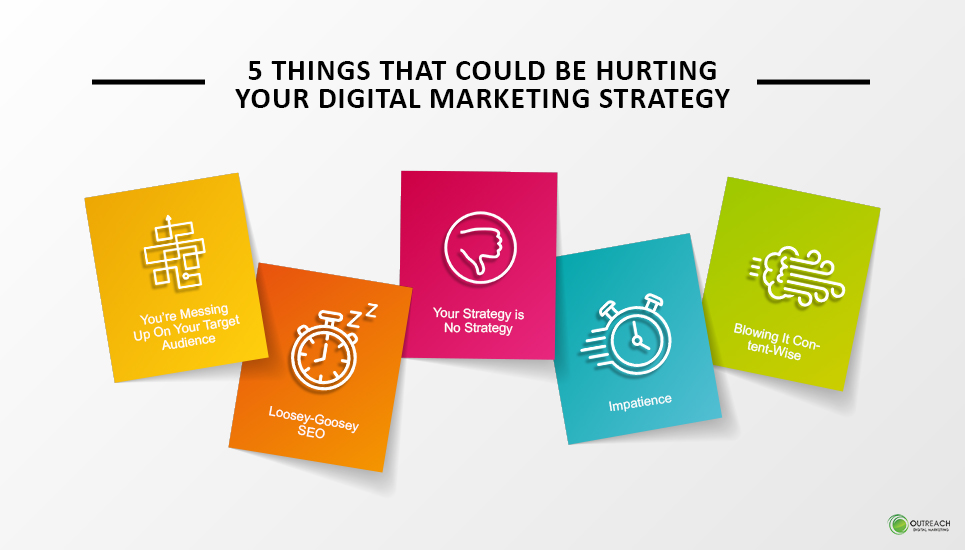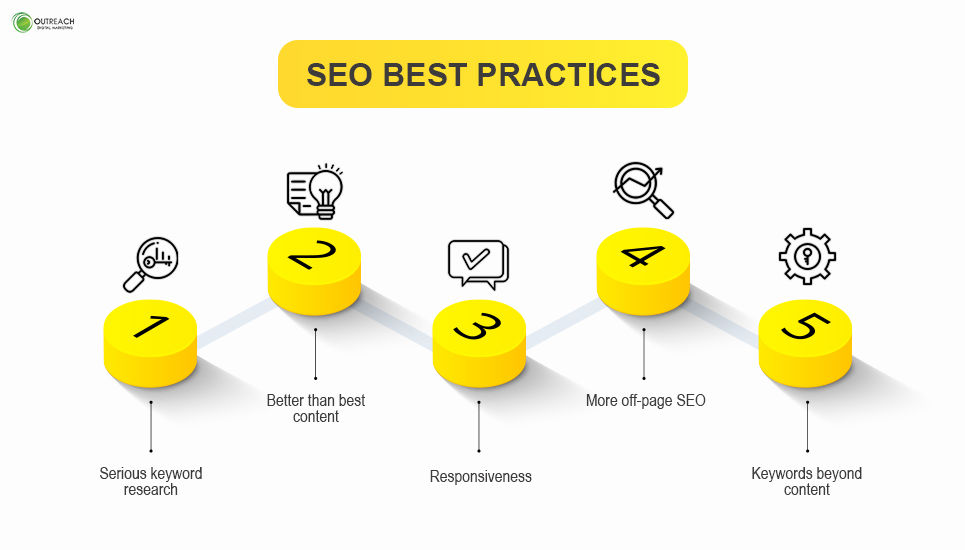Have you been feeling everything you do for your digital marketing of late is destined to fail? If so, it could be because your strategy isn’t as effective as you thought. Here we look at five things that could be hurting your digital marketing strategy with solutions to help you correct them.

1. You’re Messing Up On Your Target Audience
You’re probably thinking, okay, phew, this one isn’t me. But are you sure? Creating too broad an audience, even if it does speak to a broad selection of people you need to target, could be impacting your ROI. Although you might think wait, I can reach more people with my broader audience, this is what is likely killing you. In fact, only 25% of digital ad investments reach the right audience. The wider you cast the net, the more people there are likely not as interested in your offering. That’s why you need personas.
What are Personas?
Personas focus on a highly concentrated group of people most likely to be interested in you. As a result, you reach high-quality groups based on very specific needs and problems only you can solve. Personas weed out the wishy-washy majority not willing to commit. They provide new groups you didn’t consider. You gain insights to create effective, highly targeted campaigns. You still base marketing on common things that help find higher quality leads, like pain points, but personas fine-tune targets based on personalized details like behavior patterns and interests.
Know Your Customers
The main thing that could be holding you back is that you haven’t taken the time to truly know your customers. When you know your customers, you can begin to create far more effective marketing campaigns. Research your customers to identify a few ideal customers based on behavior, so you understand not only who they are and how to talk to them but the channels you are most likely to find them.
Define Ideal Customers
Your customer personas begin with basics like demographics and then identify specific pain points, what they expect of your brand, and the common objections they are likely to raise before committing to a purchase.
Once you understand your personas, you can address their pain points one by one. It’s about transforming unhappy prospects with problems into happy, problem-free customers.
2. Loosey-Goosey SEO
Every burning question your personas ask begins with an online search 93% of the time. Online searches depend on SEO. However, if your SEO strategy only focuses on common keywords, and nothing more, you get lost in the shuffle. Your goal is to gain visibility amongst millions. If you’re too loosey-goosey with SEO, you won’t gain traction. You need to fine-tune your approach and strategy to stay in the game with these SEO best practices:

- Serious keyword research: Instead of focusing too much on basic keywords, you need to find keywords you are most likely to rank for. Focusing on search volume helps, but the latest craze is what’s called Latent Semantic Indexing or LSI. These keywords help Google understand the context of your content by inserting the most suitable synonyms relevant to the search. For example, if you sell coats, the LSI keywords would go beyond a basic synonym like jacket and include relevant keywords such as winter, feather down, trench, etc. If you are a mortgage company, it would be words like credit, house, down payment, credit score and even something like first-time buyer. This provides context, helping the 87% of customers starting their product searches online find you.
- Better than best content: Well-searched, well-written content that is in-depth combined with things like video or infographics increases the time on page, which Google views as engagement.
- Responsiveness: If your website isn’t optimized for mobile devices, you injure your ranking.
- More off-page SEO: One of the most authoritative forms of off-page SEO is backlinks. When highly respected domains link to your pages, this gives you street cred, so to speak.
- Keywords beyond content: Including keywords on things like your image files, URLs, meta tags, and alt tags helps SEO.
If you don’t understand SEO, it’s worth finding someone who does to ensure your strategy is on point.
3. Your Strategy is No Strategy
Small businesses often think they’ve created a digital marketing strategy when they haven’t. Strategy needs focus and vision. So just like your loosey-goosey SEO, an incoherent, unfocused strategy such as “getting more leads” is not going to work for you. You need to define your personas and then literally get SMART with your strategy:
- Specific: Define clear goals, so there is no confusion about what they mean.
- Measurable: Make sure goals are measurable so you can monitor your progress
- Attainable: Make sure you can actually achieve your goals
- Relevant: Align your goals with your brand and values as well as your personas
- Time-bound: Set target dates
From there, you can identify the channels and tools to achieve your goals. Tracking progress is key. If you aren’t reaching your goals, you’ll know early on and adjust. Your strategy allows you to constantly improve so your achievements bring more and more value. As a bonus, this defined approach allows you to collect data to make smarter decisions in the future.
4. Impatience
Impatience can cause you to make major blunders. When you expect to see results too quickly, you can pull out too soon, waste money, and see zero ROI. It’s like one of those romcom “what ifs” where the protagonist waits for their love to show at a specific time and place and, just a minute before they arrive, leaves thinking they were stood up. If they had only waited a few more minutes… you get the picture. Not seeing results as quickly as you hope is disillusioning, but digital marketing takes time to gain traction. SEO, for example, can take months, while social media campaigns can take a week or two.
It’s all progressive and helps you gain momentum like a rolling snowball. People are finicky, insecure, and untrusting on the best of days, so you need to take human flaws into consideration when measuring results. If you are using personas, strategic SEO, and a well-defined marketing strategy, your efforts will pay off. That said, there are times when you’ll need to throw in the towel and move on. Patience allows you to become a constant presence in the right channels and enjoy more wins.
5. Blowing It Content-Wise
Many common mistakes made with content also boil down to impatience. You don’t want to waste time creating quality content, so you give preference to quantity over quality. You think if you just keep posting short and sweet blogs like your competition, you’ll improve SEO, and suddenly, everyone has your brand name on their lips. But this is not the case.

Your small business needs to ace content to succeed in digital marketing. Not just blogs but also things like your About Us page that should provide information about your USP and makes it clear what you do. Your content needs to outshine the competition, which takes time and finesse. You need to create a consistent voice that is engaging to your personas and provide content that answers questions, entertains, informs, and establishes authority, and, as we said above, builds street cred.
One solid, exceptional blog per week is worth far more than 10 boring, uninspired blogs any day. You need to research content and, when possible, support your information with data. Make it more engaging with unique visuals, scannable sub-headings, infographics, or videos, and include links to other blogs and content on your site. Internal links make it easier for readers to delve deeper, instilling trust and improving on-page SEO. So how do you achieve this?
Blogs
Keep up to date on your industry: Build content from the latest news in the industry and get more creative with topics. Check out the questions that pop up when you research those topics in the “People Also Ask” section. These are the things your target is interested in learning about.
Find good ideas, make them better: Known as the “Skyscraper” technique, use relevant content that reads well, and is top-ranked and make it way better with more research and links, better images, maybe a video or infographic, etc.
Think “niche”: Find your niche and use it as a comfort zone, so you don’t find yourself writing about content irrelevant to your readers. For example, if you sell appliances, most people won’t care about overly technical facts about how they’re made. They’d prefer to read reviews.
Research: Vague information lacks substance, while facts support your claims and make everything you say more legit.
Social Channels
Find focus: Make sure your social posts are focused and have a purpose. Random posts that feel out of sorts with your audience confuse instead of inform. If you have nothing to say, ask a question instead. This creates engagement and hopefully starts some conversations.
Share posts: Following influencers and industry thought leaders can provide excellent content. Sharing relevant posts can be a great way to engage your audience.
Think local: Local marketing for small businesses is key. Consider ways to make it clear you’re local and involved in the community.
Use the right channels: You shouldn’t be on every channel, just the ones your personas love.
Leverage blogs: The easiest post you’ll ever make is a “check out our blog on so and so.” It’s an easy post and sends traffic to your site.
Use the right voice: Use a voice that speaks to your audience and stick with it.
Curate smart posts: Your posts can be inspirational, educational, or entertaining to keep people engaged.
Live stream: Consider live streaming community events, a sale at your store, or your team introducing a new product.
Engage followers: Don’t just post, but also respond to comments, ask questions, etc.
Simply put, quality content rules.
Recognizing these five mistakes will allow you to adjust your mindset and create a robust strategy that resonates with your buyer personas. We can help you avoid these issues and maximize your business. Call our team today!
